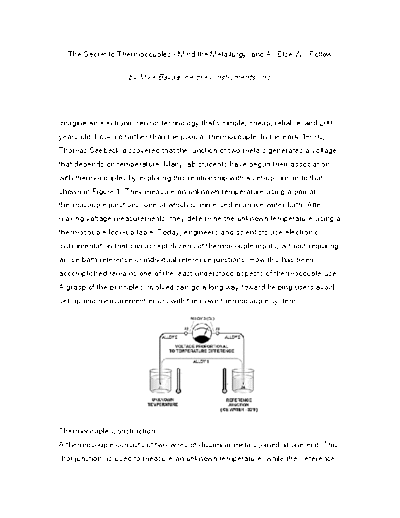Service Manuals, User Guides, Schematic Diagrams or docs for : Keithley Appnotes 5134_Thermocouple_secret
<< Back | HomeMost service manuals and schematics are PDF files, so You will need Adobre Acrobat Reader to view : Acrobat Download Some of the files are DjVu format. Readers and resources available here : DjVu Resources
For the compressed files, most common are zip and rar. Please, extract files with Your favorite compression software ( WinZip, WinRAR ... ) before viewing. If a document has multiple parts, You should download all, before extracting.
Good luck. Repair on Your own risk. Make sure You know what You are doing.
Image preview - the first page of the document

>> Download 5134_Thermocouple_secret documenatation <<
Text preview - extract from the document
The Secret to Thermocouples - Mind the Metallurgy, and All Else Will Follow
by Mike Bayda, Keithley Instruments, Inc.
Imagine an electronic sensor technology that's simple, cheap, reliable, and 200
years old. Look no farther than the popular thermocouple. In the early 1800s,
Thomas Seebeck discovered that the junction of two metals generates a voltage
that depends on temperature. Many lab students have begun their association
with thermocouples by exploring this relationship with a set-up similar to that
shown in Figure 1. They measure an unknown temperature using a pair of
thermocouple junctions, one of which is immersed in an ice water bath. After
making voltage measurements, they determine the unknown temperature using a
thermocouple look-up table. Today, engineers and scientists use electronic
instrumentation that can accept dozens of thermocouple inputs, without requiring
an ice bath reference or individual reference junctions. How this has been
accomplished remains one of the least understood aspects of thermocouple use.
A grasp of the principles involved can go a long way toward helping users avoid
set-up and measurement errors with their own thermocouple systems.
Thermocouple Construction
A thermocouple consists of two wires of dissimilar metals joined at one end. This
"hot junction" is used to measure an unknown temperature, while the "reference
(cold) junction" and measurement hardware comprise the rest of the system.
Although many metal combinations exhibit the Seebeck effect, a limited number
have been established as industry standards because of their predictable output
characteristics over a wide temperature range. The measured EMF is related to
the difference in temperature between the hot and cold junctions (J1 and J4), and
the types of metals used to construct the thermocouple. The result can be
expressed by the following equation:
V = a(TUNKNOWN -T )
REF
where a is the Seebeck Coefficient. This coefficient in highly non-linear, and
varies for different types of thermocouples. It can be found in thermocouple
references (usually in a table of voltage versus temperature), but modern
electronic instruments and software generally automate the conversion of voltage
to temperature, so the user needn't bother with a.
Simplifying the Measurement System
Modern thermocouple measurement instruments do not use the ice bath and
corresponding reference thermocouple shown in Figure 1. This eliminates the
need for a potentially large number of input channels for the references, not to
mention the hassle of dealing with ice. Historically, the purpose of the ice bath
was to force the reference junction to a known temperature (0◦ Jabse Service Manual Search 2024 ◦ Jabse Pravopis ◦ onTap.bg ◦ Other service manual resources online : Fixya ◦ eServiceinfo